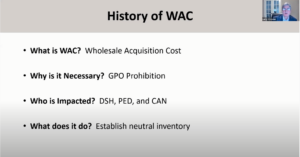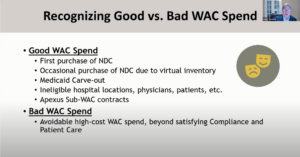Recently, Cervey’s Senior Director of 340B Solutions Larry Crowder was joined by Stephanie Dyer, 340B Program Analyst at Children’s Healthcare of Atlanta to discuss the exposure of unnecessary WAC purchases in 340B hospitals subject to GPO prohibition. Crowder and Dyer examine strategies to maximize 340B savings while prioritizing compliance and minimizing risk.
We are introducing our Webinar Rewind series where we are going back and breaking down our informative webinars into readable segments for 340B program managers, directors, buying committees, and CFO’s. Below is part 1 of this series transcript from the recent webinar, “Don’t Get WAC’d: Minimizing WAC Exposure for DSH and PED hospitals,” in which our two experts dive into financial implications, strategies, and insider insights surrounding WAC exposure in GPO prohibited hospitals.
Larry Crowder:

“Good morning and good afternoon. My name’s Larry Crowder, Senior Director of 340B Solutions a Cervey. Cervey, for those of you who don’t know who Cervey is, has been around for a really long time actually but we’ve just rebranded as Cervey. We originally started out as the technology arm of Morris & Dickson, who is the fourth largest wholesale pharmaceutical distributor. Morris & Dickson covers about 12 states in the Southeast and we were their technology arm. We’ve been doing 340B software since 2005. We heavily used our customers to get their feedback in the pharmacy, we understood the operational workflow in the pharmacy, and of course the retail pharmacies we worked with as well. In October 2019 we separated out the technology arm to form Cervey.”
“Because of customers like Stephanie and their feedback, we built the Cervey 340B suite of software solutions. Stephanie has been a big part of that, she’s been one of our customers for over a decade and I would put her at the very top of the list of customers who really understand how to manage a 340B program. Her title is 340B program analyst but Stephanie is so much more than that, she’s ACE certified and she not only understands the processes of 340B but how that relates to the compliance aspect of it.”
“Today I thought it would be really beneficial to go over how you minimize your WAC exposure if you’re a DSH hospital, a children’s hospital, or a freestanding cancer center. If you are not one of those covered entity types you can still benefit from understanding WAC exposure because we are going to be talking about reports and looking at how you find issues within your data.”
Wholesale Acquisition Cost in 340B Programs

Larry Crowder:
“I want to start out with the very basics of what is WAC? Obviously WAC stands for Wholesale Acquisition Cost, this is the cost that your wholesaler or your distributor pays for the product typically. There are some contracts that are on the WAC account through Apexus and some individual contracts that may be loaded on the account, but typically that account is your highest cost account. So that is what the WAC account is.”
“Why is it necessary? It’s necessary because of this pesky rule called the GPO prohibition. Again, this applies to the DSH, or cancer, or children’s hospitals. The GPO prohibition basically states that if you buy an item at GPO price, your group purchasing organization price, and then you use that in the outpatient area you are breaking the statute. You’re basically out of compliance. Back in 2010 this was looked at and they determined that most models were buying everything at GPO and then using those in the outpatient areas, which was a violation of the GPO prohibition rule. In 2013, they basically came out with the need for this WAC account.”
“A WAC account helps establish that neutral inventory. Instead of buying initially at GPO and using that everywhere, and then just accumulating your outpatient usage for 340B, now you would need to buy on this neutral account, which is the WAC account. It’s a non-GPO account. Then you have to accumulate usage on both your inpatient and your outpatient. And the inpatient you can use your GPO pricing, and the outpatient you can use your 340B pricing. That is where the WAC account came from and it’s really the big push to add integrity to the 340B program. They call it the age of integrity of 340B. And that’s really where this came from.”
“So today we’re going to talk about the steps to not getting WAC’d, to not spending unnecessarily on the WAC account. You’ll notice, I talk about recognizing good versus bad WAC spend. And really you can interchange those words with necessary versus unnecessary WAC spend. You are going to have some necessary WAC spend, it’s just part of the program in order to create that neutral inventory, essentially. But you don’t want to be buying at WAC if it’s not necessary because, obviously, that’s a higher cost than your 340B or GPO account, most of the time.”
“We’re also going to talk about how you find those unnecessary WAC purchases. And then what do you do once you find them? And then, lastly, I do want to mention the Kalderos 340B rebate model and the impact that that’s going to have on your WAC account.”
Good vs Bad Wholesale Acquisition Cost Spending
Larry Crowder:
“Getting into recognizing the good versus the bad WAC spend. Again, this is really necessary versus unnecessary WAC spend. The good WAC spend, the necessary WAC spend, first off is your first purchase of an NDC. When you’re creating that neutral inventory the first time you buy an NDC on the GPO account, and then use it in the outpatient area, you’re going to be non-compliant. You want to buy that first purchase on WAC and then you’re going to be using it in the different areas of the hospital.”
“The occasional purchase of an NDC due to virtual inventory, it’s really speaking to the fact that you’re going to be using that package in the two different areas. If you’re using 50% of that package in inpatient and 50% in outpatient then it’s going to necessitate a second WAC purchase. So that’s something that is just necessary, you have to do that.”
“The third is the Medicaid carve-out. If you are carving out Medicaid, and it’s an eligible outpatient that’s using Medicaid, you’re going to have to buy that at WAC because the GPO prohibition still applies. Even though you’re not using that for 340B you can’t use it with GPO pricing because you would violate the GPO prohibition.”
To learn more about Carve In vs Carve-Out in Medicaid, check out our 340B Basics Webinar Series: Part 3 here.
“Ineligible hospital locations, physicians, patients, is really referring to the patient definition. So if you have an outpatient pharmacy, an example of this would be having an outpatient pharmacy that’s open to the public, if someone from the public comes into your hospital and you dispense them a drug in an outpatient area, in this retail pharmacy, then that is not eligible for 340B pricing. You still have the GPO prohibition so you’re going to have to buy that at WAC. And the same thing happens if it’s a location that’s not an eligible location or a physician wrote the script that’s not a physician employed by, or contracted by, the hospital. You are going to have to purchase that at WAC.”
“Finally another good WAC spend would be the Apexus sub-WAC contracts. They do add some contracts to your WAC account that will sometimes be even below what you would pay from your inpatient account, and sometimes even your 340B account. But the WAC account, when the price is lower, obviously that’s the inventory neutral account and you can buy on that anytime. So if you’re saving money on that account then it would be worth a spend on that.”
“The bad WAC spend is this avoidable high-cost WAC spend on items that are not for satisfying compliance and not for patient safety. It is WAC spend that is unnecessary.”
“Stephanie, I know that Children’s Atlanta does a lot of things to mitigate your WAC spend. Can you speak a little bit to some things that you do or what you think about the WAC spend?”
Stephanie Dyer:
“One report that we use is a new items report and we get sent that report daily to our emails. And that will show if we have a new purchase on any of our WAC accounts that we have. Then it would be my job, and one of the tech’s jobs for barcoding purposes, to go and research to see if that truly was a new item and if so what was the purpose? Was it a backorder issue? A shortage issue? Are we really moving towards that new product because it has a better contract? That would be some of the things that we look at daily for WAC purchases.”
“Some of the good WAC spending, as you said, may not always be your first purchase at WAC but it could be your second or third, depending on where it’s being used and which location, as well as the par level on your shelf.”
Larry Crowder:
“That’s a good point. Stephanie’s basically saying even if you don’t have it dispensed in separate areas, so if you’re dispensing a package and this one package is all being dispensed in the outpatient area, for instance, you will have to reorder that product before you run out of it. You are going to have some WAC spend just in that little timing of needing to buy that product again before you run out of it. If you haven’t reached the full package, and you haven’t accumulated it to buy it on 340B, then you are going to have to buy it at WAC again.”

Finding Unnecessary WAC Purchases
Larry Crowder:
Stephanie spoke a little bit about this, about her reports that she does, but one of the things that we recommend is you want to establish your normal monthly WAC spend. This doesn’t have to be what you want it to be, it just is establishing what it is today. You want to establish how much WAC you are purchasing. You can look at the percentage of purchases, you can look at the percentage of 340B savings or any way that you want to look at it, but you want to establish that normal amount. Do that today and start monitoring that. When you monitor that you’re going to be tracking it and seeing what the trends are. Is that staying steady? Is it going up or down? And as you start implementing some of these processes we talk about today hopefully you’re going to see that WAC spend go down or your savings interruption, those 340B savings, increase based on what you’re doing to identify these WAC spends.”
“Utilize your third-party administrator (TPA) for reporting. If you have software you want to make sure that you’re using that software to run the reports to see which accounts, or which items that you’re purchasing at WAC, that are really causing the high WAC spend, if you’re dealing with that. And then, again, just drill down to those items. So once you find those items what do you do with those items?”

“Stephanie, you were talking about the weekly reports you run on the WAC account. Can you talk through what you’re looking for in those reports, and what you see, and how you track and trend? Then are you only doing it weekly or do you do it monthly and quarterly, or is it just the weekly reports and you’re dealing with that?”
Stephanie Dyer:
“We do weekly, and monthly, and quarterly. So weekly we look at the percentage of savings. We run a savings report and we look at the amount of losses we had from any WAC purchases. And I focus on the top five items that we’ve lost money that week. So I go through and look to see, “Okay, we ordered what? 10 flats and we should have ordered nine,” or something like that. Then all of that information gets emailed out to the managers, as well as the buyers, because it kind of puts more responsibility on the buyers to let us know the reason why they did make that WAC purchase. Then we put it in the spreadsheet and we monitor it throughout the whole year.”
“Then another thing we look at are, what you said was high dollar WAC losses, but I also like to look at quantity. Like are you buying two or three bottles, in a month, of the same Tylenol at WAC? If so then you know something’s wrong with your EHR system. Maybe your NDC’s not in line with what your buyer knows to purchase. So I not only look at what we’re losing the most amount of money on but the quantity of items as well. And just in four years, just making the buyers have that responsibility, we used to lose like 168K at WAC and now we’re down to 60k annually.”
At its core, the 340B program seeks to maximize your facilities budget so that you can better the community. One of the best ways to make sure that deserving patients continue to benefit from 340B program savings is stay on top of your wholesale acquisition cost spending.
Follow us to stay tuned for part 2 of the Webinar Rewind series for “Don’t Get WAC’d: Minimizing WAC Exposure for DSH and PED hospitals” here:
Looking for the rest of the webinar series? Check out parts 2-4 below:










